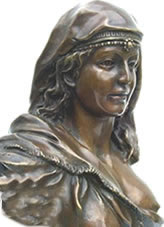Francis Hindes Groome
Born in Suffolk in 1851, Francis Groome became a Gypsiologist whilst studying at Oxford. He travelled throughout England, Wales and Europe, meeting Gypsies and studying their language.
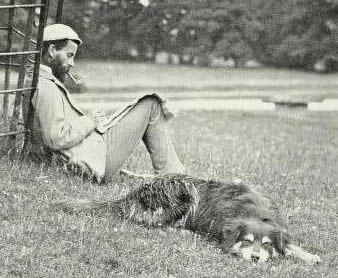
Back in England he first married Britannia Lee but then formed a liaison with Esmeralda, a vivacious singer/dancer of the Lock tribe, and she left her much older husband to live with him in Germany.
They returned to Edinburgh in 1876 and Groome entered a scholarly life. He was still involved with travellers though and over the next 4 years corresponded with Welsh Gypsy harpist John Roberts of Newtown. Roberts furnished him with many anecdotes, folktales and Romani words, which Groome used in his first book, In Gypsy Tents, published in 1880.
Groome became editor of the Journal of the Gypsy Lore Society from 1888 to '92. John Sampson, another member of the Society, supplied Groome with more folktales for his second book, Gypsy Folk Tales, published in 1899.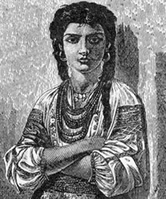
Meanwhile, Esmeralda had left him in Scotland and was leading a wild and exciting life, being painted by Augustus John and Dante Gabriel Rossetti. It was too much for Groome, and they separated.But he missed his wife and their rambles together, and he died in 1902 aged 50. Esmeralda ended up in a caravan in Prestatyn, North Wales, where she died in 1939.
Dr John Sampson
John Sampson was born in 1862 in Ireland but moved to Liverpool as a child. He developed a deep interest in languages and became Librarian of Liverpool University from 1892 to 1928. His passion for Gypsies began as a young man when he read George Borrow, and in the 1880s he started corresponding with Francis Hindes Groome. When the Gypsy Lore Society was founded in 1888 he soon became a member.
Initially, Sampson met up with Gypsies and tinkers in the north of England and learnt to speak Anglo-Romani and Shelta. Then in 1894 he met Edward Wood near Bala, and: "for the first time I heard from a British-born Kalo the Romani language spoken not as an uncouth jargon, but as a pure Indian idiom, a veritable mother tongue, miraculously preserved from corruption". Two years later he met Matthew Wood and his sons. Between them all, they immersed Sampson in the Kalo-Romani language and introduced him to many of the Rom in North Wales. His close relationship with them earned him the title of 'Rai' (gentleman).
In 1896 Sampson started working on a dictionary of Welsh Romani; it was published 30 years later in 1926 as The Dialect of the Gypsies of Wales, being the older form of British Romani preserved in the speech of the clan of Abram Wood. To help him, he harnessed the enthusiasm of four female 'disciples': Dora Yates, Agnes Marston, Eileen Lyster and Gladys Imlach.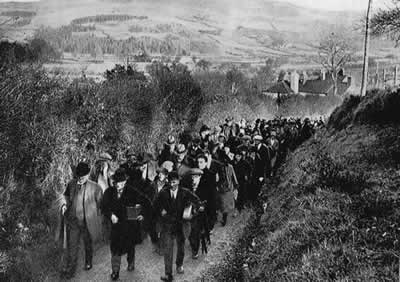
In 1909 Sampson rented a house in the small village of Bettws-Gwerfil-Goch near Corwen. It served both as a family home and as a base for Romany excursions, and it was often visited by his friends, colleagues and female assistants from Liverpool.Among the visitors were the Reverend George Hall (who wrote "The Gypsy Parson" in 1915) and charismatic artist Augustus John.
When Sampson died in November 1931 his executors were the faithful Dora Yates and Scott MacFie (secretary of the Gypsy Lore Society). They put an advertisement in the Liverpool Echo as follows:
Dr John Sampson's ashes will be scattered upon Foel Coch, Llangum, near Corwen, on Saturday next, the 21st instant, at 12.30 pm. All gypsies in the neighbourhood who desire to be present should assemble with fiddles and harps at the Inn, Llangum, at 12 noon.
And come they did. Those present included Reuben Roberts, his son and grandson, Harry Turpin Wood with his wife and children, Manfri, Jim and Howell Wood, Ben Mathias, Rosie and Mary Lizzie Griffiths.
Ithal Lee from Birkenhead, carrying the casket of ashes, and Augustus John led a colourful procession of Gypsies, university professors and scholars, ladies and gentlemen, and local villagers up the mountainside of Foel Goch: a parade of bright red bandanas and diklos, moleskin waistcoats and hobnail boots, flat caps, bowler hats, fur collars and plus fours. Scott MacFie, swathed in a scarf, rode up the track on a pony.
On a plateau below the summit, against a backdrop of the Berwyns and Snowdon Range, the final Romany ceremony was carried out. Wearing a red spotted diklo, Augustus John gave the oration; Sampson's son Michael scattered the ashes over the mountain in nine handfuls; and the mourners said the Romany lines to the dead: "Te soves misto" (may you sleep well). Reuben Roberts began the Welsh laments with his triple harp, and Turpin Wood and Rosie Griffiths took up the tune on their violins. Others joined in with more harps and fiddles, a flute, zither, clarinet and dulcimer. Finally, the casket was burnt, and Ithal Lee respectfully lit his pipe from the embers.
After trooping down the mountain track, the mourners enjoyed a funeral feast at the White Lion Hotel in Cerrigydrudion. Singing and dancing, good wine and cigars, finished off the eventful day.
Augustus John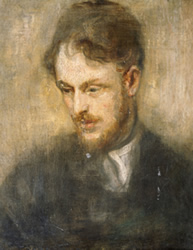
A flamboyant portrait painter with a bohemian life-style, Augustus Edwin John was born in Pembrokeshire in 1878. When he was 19 he hit his head on a rock whilst diving into the sea, and it was said this either caused or aggravated his extreme behaviour - he became well known for drinking heavily, having many amorous relationships, and fathering numerous children.
In 1901 he started teaching at the art school in Liverpool. His long hair, gold earrings and lively clothes deterred the more staid academics but he formed a strong friendship with John Sampson, the Librarian at the University. Together they visited Gypsy camps, including "Cabbage Hall" near Liverpool, which was a wintering ground for the Boswells among others, and Augustus became enchanted by his romantic view of Romany life.
He married Ida Nettleship but also fell in love with Dorothy McNeill, whom he called Dorelia, and the three adults plus several children rattled around England, Wales and Ireland in a couple of Gypsy caravans. Ida died in 1907, leaving Augustus and Dorelia to settle down in Dorset with the combined broods of seven children. Gypsy tents and bright yellow and blue caravans were kept in the grounds, ready for their many visitors.
In 1927 they moved to Hampshire, where Augustus would pat the heads of all the village children, just incase they were his offspring.
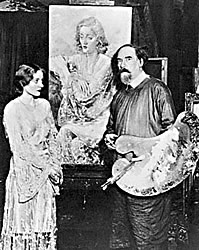
Augustus became the foremost portrait painter of his day, painting for example Dylan Thomas, T E Lawrence and Thomas Hardy. He was a member of the Royal Academy and president of the Royal Cambrian Academy of Art.
All the same he remained interested in Gypsies, and they appear in many of his drawings and paintings. He contributed to the journal of the Gypsy Lore Society and was its president from 1937-1961. He also campaigned for Gypsies' and travellers' rights.
In 1931 his friend John Sampson died, and Augustus read the lament at his funeral on top of Foel Goch. Augustus died in 1961, after a chaotic and adventurous life.
Strict Copyright Warning
All texts/audio/still/motion picture images are strictly copyright to ValleyStream Media 1980-2010 or to the stated contributor/
copyright holder/s or "unKn". Any unauthorised copying of any images or material from this website for any use is strictly prohibited without written permission from the image owners - owners of unknown images ("unKn") from this website please contact us for fair use or image withdrawal. All rights reserved.
